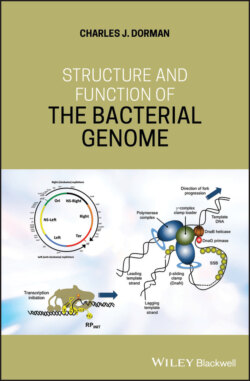Читать книгу Structure and Function of the Bacterial Genome - Charles J. Dorman - Страница 32
1.21 MukB, a Condensin‐Like Protein
ОглавлениеThe bacterial chromosome is maintained in an orderly superstructure to facilitate replication, transcription, and other DNA‐based transactions. The family of SMC proteins play an important role in achieving this organisation (Uhlmann 2016). These large polypeptides have a DNA‐binding head domain and long coiled‐coil domains that bring the head‐domain‐DNA complexes together in a condensed nucleoprotein complex (Figure 1.10). The head domains have ATPase activity and a DNA‐binding hinge region in the coiled‐coil domain promotes dimer formation (Chen, N., et al. 2008; Kumar et al. 2017a). SMC activity is found in eukaryotes and in prokaryotes, with one of the best‐studied examples of an SMC‐like protein in bacteria being the MukB protein from E. coli (Niki et al. 1991; Rybenkov et al. 2014).
MukB forms topologically stable loops in the chromosomal DNA and protects the supercoils in these protected loops (Kumar et al. 2017a). It forms a complex with the MukE and MukF proteins, with these seeming to play a role in the turnover of the MukB complex on DNA in combination with the ATPase activity of MukB itself (Kumar et al. 2017a). MukF performs a bridging role between the ATPase heads of the two MukB in the complex (Figure 1.10). Proteins performing this task in SMC complexes are called kleisins. The equivalent system in B. subtilis and C. crescentus consists of the proteins Smc (MukB), ScpA (MukF, kleisin), and ScpB (MukE): the ‘Scp’ designation indicates that the protein is a ‘segregation and condensation protein’ (Britton et al. 1998; Burmann et al. 2013; Jensen and Shapiro 1999, 2003; Mascarenhas et al. 2005).
The MukBEF complex has important architectural and segregational roles in the nucleoid, operating mainly outside the Ter macrodomain of the chromosome. Its principal site of action seems to be at ori and MukB requires MukE, MukF, and ATP hydrolysis to gain and maintain this association; MukBEF/SMC complexes do not seem to track moving replisomes (Badrinarayanan et al. 2012a,b; Danilova et al. 2007; Gruber and Errington 2009; Sullivan et al. 2009). MukBEF is responsible for guiding the newly replicated ori regions into the two halves of the cell, driving bipolar segregation; if MukBEF is removed, the ori shifts from mid‐cell to the pole, disturbing normal chromosome orientation and segregation patterns (Danilova et al. 2007). Inside the Ter macrodomain, the MatP protein prevents MukBEF from playing a structural role by displacing it and so making it available for ori binding (Lioy et al. 2018; Nolivos and Sherratt 2014; Nolivos et al. 2016). The MukBEF complex is not required for sister chromosome cohesion because muk mutants have a higher degree of cohesion of sister chromosomes than wild‐type cells (Danilova et al. 2007).
Despite being able to stimulate Topo IV activity by direct interaction (Hayama and Marians 2010; Hayama et al. 2013; Li et al. 2010; Vos et al. 2013), MukBEF forms a complex with Topo IV that seems to stabilise MukBEF on the DNA and drive chromosome condensation independently of the catalytic activities of the topoisomerase (Kumar et al. 2017b). This observation is indicative of an architectural role for the MukBEF‐Topo‐IV complex. Data from chromosome conformation capture experiments show that, together with the HU NAP, MukBEF promotes long‐range DNA contacts in the megabase range (Lioy et al. 2018), adding further detail to our picture of the nucleoid‐structuring contributions of MukBEF. However, the MukBEF‐Topo‐IV complex also has functions in chromosome segregation that do depend on the catalytic properties of Topo IV. The complex is responsible for the timely decatenation of newly replicated ori copies and their segregation (Figure 1.10), while also contributing to the management of DNA supercoiling set points (Zawadzki et al. 2015). The primary site of action of the MukBEF‐Topo‐IV complex has been regarded as ori, with MukBEF recruiting the topoisomerase to that region of the chromosome (Nicolas et al. 2014). It is becoming clear that MukBEF‐Topo‐IV has a much more dynamic relationship with the chromosome, both spatially and temporally, and that its relationship with the MatP protein in ter has an important management role in its choreography. The final stages of chromosome replication and the associated need to effect decatenation in a timely manner are consistent with a need to grant MukBEF‐Topo‐IV access to ter to perform the necessary cohesion/decatenation steps, with MatP then evicting the complex, making it available for re‐association with ori (Nolivos et al. 2016).
